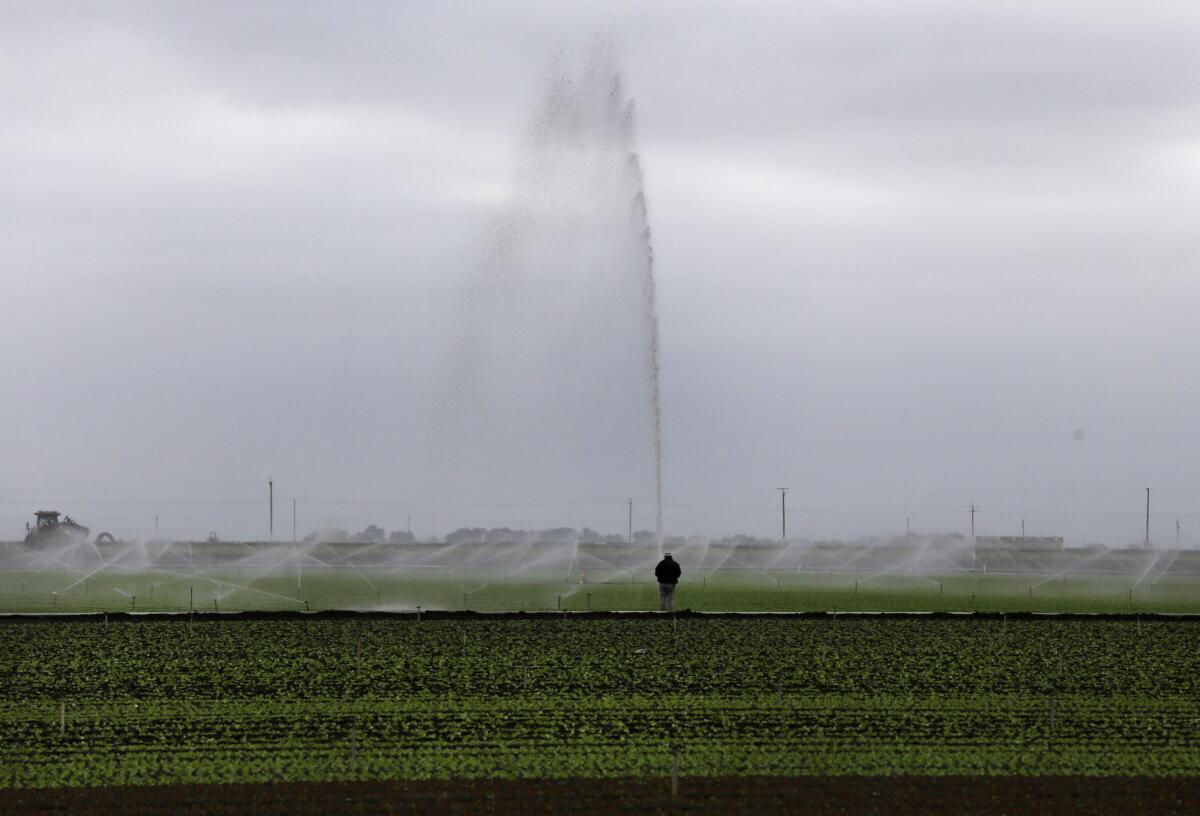One water district is trying to make sure agriculture cleans up its own mess

- Share via
A Central California water board is poised to do something rare in American agriculture: It is trying to establish enforcement mechanisms — not just toothless regulations — to limit the use of farm fertilizers that contribute to dangerous levels of groundwater pollution. If the effort is successful, within a few decades it will have reversed or at least stopped adding to the pollution of groundwater beneath the Salinas and Santa Maria valleys.
One of the most pervasive forms of groundwater pollution is nitrate, a key component of farm fertilizer and manure. In 2017, water systems serving 10.9 million Californians were contaminated with nitrate at or above legal limits, according to a study published in June by the Environmental Working Group. In infants, nitrate can cause the potentially fatal oxygen-deficiency disease known as “blue baby syndrome.” Even at levels below federal guidelines, the EWG says, nitrate exposure is linked to colorectal, ovarian, thyroid, kidney and bladder cancers.
The Central Coast Regional Water Quality Control Board oversees water pollution in a district that extends from south of Santa Barbara to north of Santa Cruz, a region at the heart of the state’s high-end vegetable agriculture. In 2004, the water board instituted a nitrate-monitoring program. Now it wants to impose restrictions on farmers’ nitrate use, and ultimately to cite and fine those who don’t heed the limits. The restrictions would work to gradually reduce the use of nitrate until no excess percolates into groundwater.
If the plan, now in the public-comment stage, succeeds, it could have far-reaching impact. The approach would be particularly applicable in the nearby Central Valley, where California’s agriculture industry predominates. Parts of the Central Valley have nitrate-reduction programs of their own, but they lack enforcement provisions.
The Central Coast’s favorable Mediterranean climate and rich soils enable farmers to plant three or four crops per year, giving their fields some of the nation’s highest per-acre productivity. But that means the fields also receive three or four applications of fertilizer a year. As a result, nitrate pollution levels in some parts of the region are among the highest in California, according to Matt Keeling, the Central Coast board’s executive officer.
For farmers, nitrate has a benefit — the substance increases crop yields whether it comes from fertilizer or groundwater irrigation. But for local communities and, increasingly, nearby metropolitan areas that use groundwater for drinking, the costs of filtration, or of digging deeper wells to get to cleaner water, are rising. Not surprisingly, a UC Berkeley study showed that those whose taps deliver the highest levels of nitrates in the San Joaquin Valley are disproportionately poor and Latino.
The Central Coast water board’s proposed regulations wouldn’t prevent farmers from using nitrate. Instead, farmers would be required to gradually subtract from their fertilizer applications the amount of nitrate in the groundwater they pump onto their fields. The goal is to reach an optimal level — as much but no more than the crops can absorb — which would mean less and less in the groundwater.
Over a generation or two, the water would get cleaned up and farmers could maintain their crops. However, farmers whose groundwater nitrate levels didn’t decrease would face progressively intensifying enforcement, starting with requests for compliance and ending with fines.
For farmers, the measure remains a hard sell. Many want to increase, not decrease, nitrate applications. Data collected by the Central Coast water board bears this out: More than half of the region’s farmers report that they apply more nitrate than is recommended for their crops, and some use two to four times as much, according to Keeling.
Kari Fisher, the California Farm Bureau Federation’s senior counsel, speaks for the farmers. She told me that the water board’s draft order “could lead to losses of up to 11,000 jobs and $309 million in income, mostly in disadvantaged communities.”
Keeling declined to address the federation’s estimates, but he acknowledges that by 2026, the nitrate restrictions would require farmers to modify their practices — switching to crops that are particularly good at absorbing nitrate, such as broccoli, or reducing crop cycles per year. The six-year time horizon is meant to give farmers time to experiment and innovate to better cope with altered nitrate regimens.
The cost to farmers also must be weighed against the health and water purification costs that nitrate pollution imposes. A 2012 UC Davis study of nitrate in the Salinas Valley and in the Central Valley’s Tulare Lake basin estimated the cost of providing clean drinking water to out-of-compliance local public water systems at $17 million to $34 million a year.
Agriculture’s pollution, arising not just from fertilizer but pesticides, antibiotics and soil degradation, is far-reaching, and no program to reverse California’s growing environmental disarray can succeed without curbing it. Addressing the nitrate problem is an obvious place to start.
Jacques Leslie is a contributing writer to Opinion.
More to Read
A cure for the common opinion
Get thought-provoking perspectives with our weekly newsletter.
You may occasionally receive promotional content from the Los Angeles Times.









